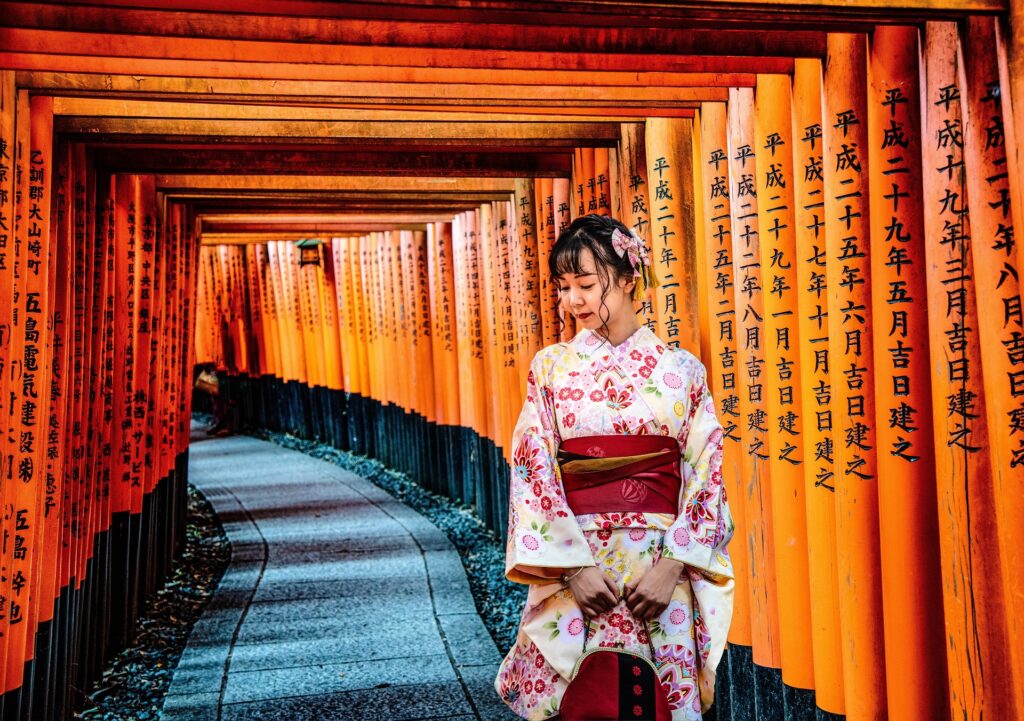1 Day in Kyoto: Temples, Tea Ceremonies, and Timeless Traditions
Kyoto, Japan’s ancient capital, is a city where time slows down. Here, mist-cloaked temples whisper tales of samurai, cobblestone alleys lead to hidden teahouses, and every season paints the landscape in bold strokes—cherry blossoms in spring, fiery maples in autumn. But to truly experience Kyoto, you must live it like a local. Let’s walk through a perfect day in this cultural treasure trove, blending iconic sights with secrets even seasoned travellers miss.
Table of Contents
Morning: Temples and Tranquility

6:30 AM: Sunrise at Kinkaku-ji (The Golden Pavilion)
Start your day early at Kyoto’s most iconic temple. Arriving at dawn lets you avoid the crowds and see the gold-leaf-covered pavilion shimmer in the soft morning light. Built-in 1397 as a retirement villa for a shogun, Kinkaku-ji became a Zen temple after his death. The reflection of the structure in the mirror-like pond is a lesson in wabi-sabi—the beauty of impermanence.
Pro Tip: The temple opens at 9 AM, but the surrounding gardens open earlier. Stroll the mossy paths and listen to the shishi-odoshi (deer scarer) bamboo clacks—a sound designed to startle pests, now a symbol of peace.

8:30 AM: Zen Meditation at Ryoan-ji
A 15-minute bike ride away lies Ryoan-ji, home to Japan’s most famous Zen rock garden. This 15th-century masterpiece features 15 rocks arranged in raked white gravel, though you can only ever see 14 at once—a metaphor for life’s incompleteness. Join a morning meditation session (offered to early visitors) and let the garden’s simplicity quiet your mind.
Local Insight: “The rocks aren’t just placed randomly,” explains monk Hiroshi Tanaka. “Their arrangement mirrors the cycle of human desire and enlightenment.”
Afternoon: Tea, Tastes, and Tradition

12:00 PM: Lunch at Nishiki Market
Dive into Kyoto’s culinary soul at Nishiki Market, a 400-year-old arcade dubbed “Kyoto’s Kitchen.” Skip the generic street food and try:
- Yudofu: Silken tofu simmered in kombu broth—a Kyoto speciality.
- Matcha Warabi Mochi: Jelly-like sweets dusted with roasted soybean flour.
- Pickled Vegetables: Kyoto’s tsukemono are fermented for months in wooden barrels.
Did You Know? Over 130 vendors operate here, many for generations. Look for shops with shinise (old establishment) plaques—they’ve survived centuries.

2:00 PM: Tea Ceremony in a Gion Teahouse
No Kyoto day is complete without a chanoyu (tea ceremony). Book a private session in Gion, the geisha district, where kimono-clad hosts demonstrate the ritual’s four principles: harmony, respect, purity, and tranquillity.
Step-by-Step:
- Purify: Rinse hands with water from a stone basin.
- Prepare: Watch the host whisk matcha into a froth with a bamboo chasen.
- Savour: Rotate the bowl twice before drinking to honour its craftsmanship.
“The tea ceremony isn’t about tea—it’s about mindfulness,” says tea master Akira Yamamoto.
Evening: Lanterns, Legends, and Lullabies

5:30 PM: Sunset at Fushimi Inari Taisha
As dusk falls, hike the trails of Fushimi Inari, famed for its thousands of vermilion torii gates. Most tourists cluster at the base, but venture halfway up Mount Inari for a serene view of Kyoto bathed in golden light. The gates, donated by businesses seeking blessings from Inari, the Shinto god of rice, form a tunnel of wishes.
Hidden Gem: Detour to the quieter Senbon Torii (Thousand Gates) path—equally stunning, less crowded.

7:30 PM: Kaiseki Dinner in a Machiya Townhouse
End your day with kaiseki, Japan’s haute cuisine. Reserve a table at a restored machiya (wooden townhouse), where chefs craft multi-course meals celebrating seasonal ingredients. Autumn might bring chestnut soup and persimmon tofu; spring features cherry blossom-infured sashimi.
Must-Try: Yuba (tofu skin), a Kyoto delicacy served in delicate ribbons.

Nightcap: Stroll Through Pontocho Alley
Slip into Pontocho, a narrow alley lit by paper lanterns. This 400-meter stretch is lined with ochaya (teahouses) where geiko (Kyoto’s geisha) entertains. While most teahouses are invitation-only, you can peek into open doors or sip sake at a riverside bar.
Local Secret: Visit between May and September for kawayuka—dining platforms suspended over the Kamogawa River.
Why This Itinerary Works
- Balances Iconic & Hidden: From Golden Pavilion crowds to secluded torii gates.
- Cultural Immersion: Tea ceremonies, monk-led meditation, and seasonal cuisine.
- Respect Rhythm: Matches Kyoto’s unhurried pace—no rushed checklists.

Ready to Explore Kyoto?
Kyoto isn’t a city to conquer; it’s a feeling to absorb. Whether you’re tracing samurai history or savouring matcha, let its traditions slow you down. For deeper dives, check out our [Kyoto Seasonal Guide] or [Hidden Temples Map].
Test Your Knowledge: Which Kyoto temple features a rock garden you can’t fully see? (Answer: Ryoan-ji!)
Loved this? Share your favourite Kyoto moment below— 🌸🍵
